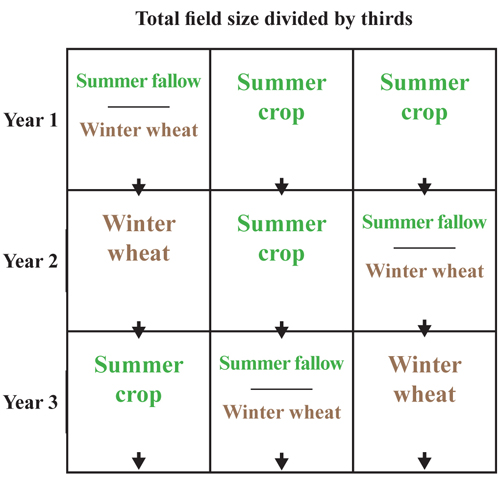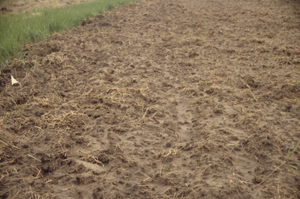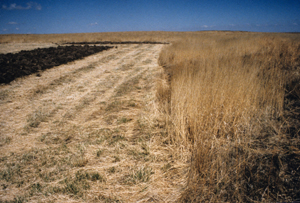G1943
Converting CRP to Cropland in the Nebraska Panhandle
This NebGuide discusses the benefits and costs of converting Nebraska Panhandle CRP to cropland. Chemical and mechanical control of CRP grasses is discussed.
Drew J. Lyon, Extension Dryland Crops Specialist
Thomas L. Holman, Extension Educator
|
When contemplating the return of CRP ground to crops, consider the $100 to $125 per acre cost to establish a good stand of grass in CRP and the income potential from future grain production.
In the Nebraska Panhandle most CRP ground returned to crop production initially will be sown to winter wheat, proso millet, or a combination of the two crops. In recent years, grain prices have been highly variable and price volatility means price risk. The demand for grazing either within or outside a producer’s operation, the availability of water, and water development and fencing costs need to be considered before preparing to return CRP ground to cropping.
CRP Vegetation Control
Chemical Control
Vegetation may be controlled by herbicides and/or tillage. A conversion strategy using minimum tillage and timely herbicide application can be effective for maintaining soil quality and producing acceptable yields. The key to successful chemical vegetation control is applying a systemic herbicide such as glyphosate to plants when carbohydrates (plant food) are moving to the roots. In cool-season species such as wheatgrasses and sweet clover, this occurs in the fall and late spring. However, in the Nebraska Panhandle, spring applications provide more consistent control than fall applications because plants are often under drought stress in the fall.
|
For cool-season species, allow 4-6 inches of new growth to occur in the spring before applying glyphosate. If regrowth occurs, a second glyphosate application may be required. In warm-season species such as bluestems, gramas, and switchgrass, apply herbicides in midsummer when food is moving to the plant roots. Increased herbicide coverage may be obtained by mowing, haying, grazing, or burning old growth, and allowing regrowth to occur before application. Haying and grazing may not be allowed prior to CRP contract expiration.
Mechanical Control
Tillage also may be used to control established vegetation and growers should consider both the pros and cons of its use. In land that is to be summer fallowed, tillage smooths and mellows the seedbed and allows planting with conventional drills, even under dry conditions. Untilled CRP ground can be extremely hard after a dry summer fallow period, making seeding difficult with all but the heaviest drills. Annual grass weeds such as downy brome appear to be more problematic when tillage is not used during CRP conversion.
Tillage also provides control of established vegetation when converting CRP to crop production. While herbicides have worked well when environmental conditions are favorable for rapid plant growth, under less favorable conditions they have provided inconsistent control. Using glyphosate at a rate of 24-32 oz per acre followed by tillage two weeks later can provide effective vegetation control. The drawbacks to tillage include more rapid loss of soil quality and less soil water storage (Figure 2). Tillage also may make it more difficult for producers to achieve an acceptable conservation plan, which is required to maintain eligibility for USDA programs.
Estimating Costs
Demonstration trials were conducted to evaluate the effectiveness of three tillage methods in preparing CRP ground to return to cropland (Figure 3). These methods were:
- plowing using a moldboard plow, tandem disk, and chisel plow,
- reduced-till using herbicides and non-inversion tillage, and
- no-till.
The operations and per acre estimated costs used in Tables I-III are based on Nebraska Panhandle Crop Budgets 2008 (PHREC 08-18) and the 2008 Nebraska Guide for Weed Management (EC130). Reference these cost estimates and potential proso millet income when considering whether to take CRP ground out of grass and prepare it for recropping. These estimates use a diesel fuel cost of $3.60 per gallon. The estimates would apply to the proso millet crop, the winter wheat crop to be sown in the fall, or both. They can be used to prepare a whole farm budget, depending on rotation and fallow periods. The winter wheat costs will apply to fallowed land as well as wheat acres.
Some CRP payments may be lost if the land is returned to crops. Evidenced by these three cost estimates, plowing cool-season grasses is the most practical method of preparing the land to recrop due to proso millet income. Although reduced-till was less costly, the ground was too rough to plant millet. This might be avoided by substituting a light discing for one or more of the sweep tillage operations.
To establish net costs, add the portion of the current year CRP payment lost due to cropping in May (liquidated damages) and deduct the value of the millet crop if applicable. Remittance of the CRP payment will vary. Contact your USDA Farm Service Agency (FSA) office to determine costs per acre per month. The value of the millet crop was estimated to be $60 per acre (15 cwt x $4/cwt), although millet prices are highly variable. Tables I-III also include an option to hay the CRP acres and estimate hay production at 1500 pounds of forage per acre. Consider this option only if there is sufficient growth at the time of haying and enough time to regenerate 4 inches of new growth prior to spraying glyphosate, if tillage is not used.
| Table I. Estimated operations and per acre costs for no-till conversion of CRP to cropland. | ||||
| Date | Crop | Operation | Estimated cost/acre $ |
Producer estimate $ |
| April 2 | Both | Mow or | 1.86 |
|
| Swath and condition | 6.66 |
|||
|
Bale |
9.95 |
|||
| May 8 | Both | Apply glyphosate (32 oz/acre) | 17.31 |
|
| June 4 | Both | Apply glyphosate (32 oz/acre) | 17.31 |
|
| June 12 | Millet | Plant | 12.88 |
|
| June 29 | Millet | Fertilize (30 lb N/acre) | 24.56 |
|
| July 12 | Wheat | Apply Landmaster BW (64 oz/acre) | 9.02 |
|
| Sep. 2 | Wheat | Apply Landmaster BW (54 oz/acre) | 7.73 |
|
| Both | Labor — 0.75 hours @ $10.00/hour | 7.50 |
||
| Millet | Harvest and truck | 31.79 |
||
| Both | Overhead | 3.00 |
||
| Both | Management | 9.02 |
||
| Both | Depreciation and interest on equipment | 27.79 |
||
| Millet | Apply insecticide (grasshoppers) | 8.00 |
||
| Total Cost | $177.77 |
|||
| If Hayed | $192.52 |
|||
| Table II. Estimated operations and per acre costs for reduced-till conversion of CRP to cropland (does not include millet costs). | ||||
| Date | Crop | Operation | Estimated cost/acre $ |
Producer estimate $ |
| April 2 | Wheat | Mow or | 1.86 |
|
| Swath and condition | 6.66 |
|||
| Bale | 9.95 |
|||
| May 8 | Wheat | Apply glyphosate (32 oz/acre) | 17.31 |
|
| May 22 | Wheat | Sweep tillage | 3.92 |
|
| June 7 | Wheat | Sweep tillage | 3.92 |
|
| July 12 | Wheat | Sweep tillage | 3.92 |
|
| Aug. 7 | Wheat | Chisel with deadrod | 5.50 |
|
| Sep. 11 | Wheat | Rodweed | 4.47 |
|
| Wheat | Labor — 0.90 hours @ $6.50/hour | 5.85 |
||
| Wheat | Overhead | 3.00 |
||
| Wheat | Management | 9.02 |
||
| Wheat | Depreciation and interest on equipment | 30.13 |
||
| Total Cost | $88.90 |
|||
| If Hayed | $103.65 |
|||
| Table III. Estimated operations and per acre costs for conventional conversion of CRP to cropland. | ||||
| Date | Crop | Operation | Estimated cost/acre $ |
Producer estimate $ |
| April 2 | Both | Mow or | 1.86 |
|
| Swath and condition | 6.66 |
|||
Bale |
9.95 |
|||
| May 1 | Both | Plow | 9.19 |
|
| May 2 | Both | Tandem disk | 6.08 |
|
| May 22 | Both | Tandem disk | 6.08 |
|
| June 7 | Both | Chisel w/9” sweeps and harrow | 10.89 |
|
| June 12 | Millet | Plant | 12.88 |
|
| June 29 | Millet | Fertilize (30 lb N) | 24.56 |
|
| Aug. 7 | Wheat | Chisel with deadrod | 4.27 |
|
| Sep. 11 | Wheat | Rodweed | 4.47 |
|
| Both | Labor — 0.75 hours @ $10.00/hour | 7.50 |
||
| Millet | Harvest and truck | 31.79 |
||
| Both | Overhead | 3.00 |
||
| Both | Management | 9.02 |
||
| Both | Depreciation and interest on equipment | 31.34 |
||
| Millet | Apply insecticide (grasshoppers) | 8.00 |
||
| Total Cost | $170.93 |
|||
| If Hayed | $185.68 |
|||
Intensive Crop Rotations
Converting CRP ground to crop production offers producers an excellent opportunity to establish more intensive crop rotations. By growing two crops in three years or three crops in four years, producers gain several important benefits.
- They reduce the use of fallow in the rotation. Fallow is a major contributor to soil quality degradation and is an inefficient water conservation practice. Tillage during fallow aerates the soil and hastens the decomposition of organic matter. No plants are allowed to grow during fallow, so no organic matter is added, and the soil may be eroded by wind and water.
- Weeds, insects, and other pest cycles are disrupted when summer crops are rotated with winter wheat. For example, downy brome, jointed goatgrass, and feral rye are much less troublesome in winter wheat grown in rotation with summer crops such as proso millet or sunflower.
Incorporating No-till
Summer crops often respond very favorably to no-till practices. The use of no-till for all or a portion of the rotation reduces overall tillage, leaving more crop residue on the soil surface. A producer who plans to establish a more intensive crop rotation that includes no-tilled summer crops may be less concerned about using tillage, even plowing, for the initial breakout of the CRP ground. The long-term benefits of such a cropping system may outweigh the short-term detrimental effects of a one-time plowing on soil quality.
Planning
A potential plan for CRP conversion would involve discing or plowing one-third of the field to be summer fallowed prior to seeding winter wheat in the fall (Figure 4). On the other two-thirds of the field, apply glyphosate at a rate of 32 oz per acre in early May and again in early June, if needed. Apply fertilizer and no-till seed a summer crop such as proso millet. If soil moisture is limited in the top 3 feet of soil, the summer crop should not be planted, and the area should be fallowed for a fall crop or a summer crop the next year.
 |
| Figure 4. A potential plan for CRP conversion. |
Annual grass weeds may be a problem in the no-till millet the first year out of CRP. If annual grass weed problems are anticipated, use some tillage or substitute a broadleaf summer crop such as sunflower. Do not consider planting corn at this time because adequate crop residue is not present and usually soil water is limited. In year two, half of the millet ground would be fallowed and half would be reseeded to another summer crop. By year three, a three-year system of winter wheat-summer crop-fallow would be established. Such a plan would provide income in the first year after contract expiration and establish a more intensive system, using minimum tillage or no-till to maintain the benefits of CRP for a longer time.
Fertility
Initially, soil microorganisms will use available nitrogen when they convert plant residues to soil organic matter. Nitrogen is unavailable for plant use during this time. Lack of available nitrogen may require additional fertilizer inputs during the first crop year after CRP to compensate for the immobilized nitrogen. Any soils being converted from CRP to cropland should be tested as soon as possible for nutrient needs.
Before implementing any conversion plan on land enrolled in CRP, contact your local USDA Natural Resources Conservation Service field office for assistance and to assure that FSA requirements are met. Contact your local University of Nebraska–Lincoln Extension office for more CRP conversion information.
This publication has been peer reviewed.
Visit the University of Nebraska–Lincoln Extension Publications Web site for more publications.
Index: Crop Production/Field Crops
Cropping Practices
Issued April 2009


